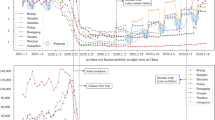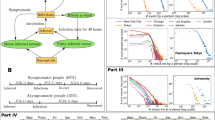Abstract
In the beginning of 2020, the COVID-19 epidemic broke out and spread all over the world in just a few months. COVID-19 spread analysis has attracted considerable research efforts in many areas including the impact of population mobility on the epidemic development. However, most studies do not use real data on population mobility, or choose an overly wide range of objects. This paper studies the COVID-19 epidemic in Shenzhen from January 26 to February 16, focusing on the impact of population mobility on the epidemic development. Combined with the population mobility data, we propose the Source-SEIR model. We estimated that the basic reproduction number of SARS-CoV-2 is 2.61. The experiment results show that the combination of population mobility data is helpful to the evaluation of the epidemic development, and the restrictions on population mobility in Shenzhen have played a role in curbing the deterioration of COVID-19 epidemic. Without restrictions on population mobility, there will be more than 600 confirmed cases of COVID-19 in Shenzhen.
Supported by: National Natural Science Foundation of China (Grant Nos. 61803266, 61703281, 91846301, 71790615, 71471118 and 71871145), Guangdong Province Natural Science Foundation (Grant Nos. 2019A1515011173 and 2019A1515011064), Shenzhen Fundamental Research-general project (Grant Nos. JCYJ20190808162601658 and JCYJ2018030512462-8810).
Access this chapter
Tax calculation will be finalised at checkout
Purchases are for personal use only
Similar content being viewed by others
References
Moore, S, Rogers, T.: Predicting the speed of epidemics spreading in networks. Phys. Rev. Lett. 124(6), 068301 (2020)
Zhou, T., Liu, Q., Yang, Z., et al.: Preliminary prediction of the basic reproduction number of the novel coronavirus 2019-nCoV. J. Evid. Based Med. 13(1), 3–7 (2020)
Wu, J.T., Leung, K., Leung, G.M.: Nowcasting and forecasting the potential domestic and international spread of the 2019-nCoV outbreak originating in Wuhan, China: a modelling study. Lancet 395(10225), 689–697 (2020)
Hao, X., Cheng, S., Wu, D., et al.: Reconstruction of the full transmission dynamics of COVID-19 in Wuhan. Nature 584(7821), 420–424 (2020)
Cao, Z., Zhang, Q., Lu, X., et al.: Incorporating human movement data to improve epidemiological estimates for 2019-nCoV. medRxiv (2020)
Lipsitch, M., Cohen, T., Cooper, B., et al.: Transmission dynamics and control of severe acute respiratory syndrome. Science 300, 1966–1970 (2003)
Bommer, C., Vollmer, S.: Average detection rate of SARS-CoV-2 infections is estimated around six percent. Lancet Infect Dis (2020)
de Arruda, G.F., Petri, G., Rodrigues, F.A., et al.: Impact of the distribution of recovery rates on disease spreading in complex networks. Phys. Rev. Res. 2(1), 013046 (2020)
Kissler, S.M., Tedijanto, C., Goldstein, E., et al.: Projecting the transmission dynamics of SARS-CoV-2 through the postpandemic period. Science 368(6493), 860–868 (2020)
Verity, R., Okell, L.C., Dorigatti, I., et al.: Estimates of the severity of coronavirus disease 2019: a model-based analysis. Lancet Infectious Dis. (2020)
Jia, J., Lu, X., Yuan, Y., et al.: Population flow drives spatio-temporal distribution of COVID-19 in China. Nature 1–5 (2020)
Du, Z., Xu, X., Wang, L., et al.: Effects of proactive social distancing on COVID-19 outbreaks in 58 cities, China. Emerg. Infect. Dis. 26(9), 2267 (2020)
Tian, H., Liu, Y., Li, Y., et al.: An investigation of transmission control measures during the first 50 days of the COVID-19 epidemic in China. Science 368(6491), 638–642 (2020)
Ali, S.T., Wang, L., Lau, E.H.Y., et al.: Serial interval of SARS-CoV-2 was shortened over time by nonpharmaceutical interventions. Science 369(6507), 1106–1109 (2020)
Cui, P., Wang, W., Cai, S., et al.: Close and ordinary social contacts: how important are they in promoting large-scale contagion? Phys. Rev. E 98(5), 052311 (2018)
Koher, A., Lentz, H.H.K., Gleeson, J.P., et al.: Contact-based model for epidemic spreading on temporal networks. Phys. Rev. X 9(3), 031017 (2019)
Liu, Y., Gu, Z., Xia, S., et al.: What are the underlying transmission patterns of Covid-19 outbreak? An age-specific social contact characterization. EClinicalMedicine 100354 (2020)
Guan, W., Ni, Z., Hu, Y., et al.: Clinical characteristics of 2019 novel coronavirus infection in China. MedRxiv (2020)
Adnerson, R.M., Anderson, B., May, R.M.: Infectious Diseases of Humans: Dynamics and Control. Oxford University Press, Oxford (1992)
Wallinga, J., Lipsitch, M.: How generation intervals shape the relationship between growth rates and reproductive numbers. Proc. Roy. Soc. B: Biol. Sci. 274(1609), 599–604 (2007)
Xu, X., Wen, C., Zhang, G., et al.: The geographical destination distribution and effect of outflow population of Wuhan when the outbreak of the 2019-nCoV Pneumonia. J. Univ. Electron. Sci. Technol. China 49, 1–6 (2020)
Author information
Authors and Affiliations
Editor information
Editors and Affiliations
Rights and permissions
Copyright information
© 2021 Springer Nature Singapore Pte Ltd.
About this paper
Cite this paper
Wu, Z. et al. (2021). Population Mobility Driven COVID-19 Analysis in Shenzhen. In: Sun, Y., Liu, D., Liao, H., Fan, H., Gao, L. (eds) Computer Supported Cooperative Work and Social Computing. ChineseCSCW 2020. Communications in Computer and Information Science, vol 1330. Springer, Singapore. https://doi.org/10.1007/978-981-16-2540-4_55
Download citation
DOI: https://doi.org/10.1007/978-981-16-2540-4_55
Published:
Publisher Name: Springer, Singapore
Print ISBN: 978-981-16-2539-8
Online ISBN: 978-981-16-2540-4
eBook Packages: Computer ScienceComputer Science (R0)





